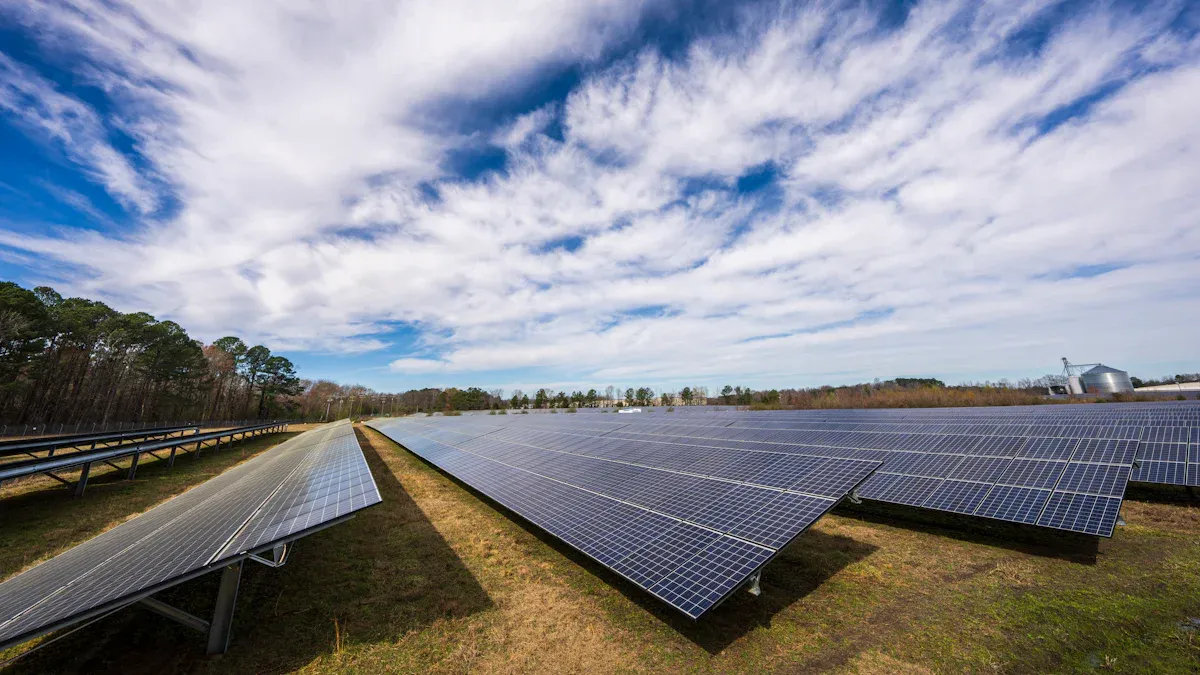
You power electronic shelflabels in retail with several options: batteries, energy harvesting, and wired connections. Most retail stores rely on coin cell batteries, lithium-ion batteries, or direct wiring to keep systems like the ESL Gateway AP and ESL Price Tag running efficiently. Reliable energy ensures your Esl Retail operation never experiences pricing errors or display downtime. Consistent power keeps electronic shelf labels accurate and responsive for you and your customers.
Battery Power in Electronic Shelf Labels
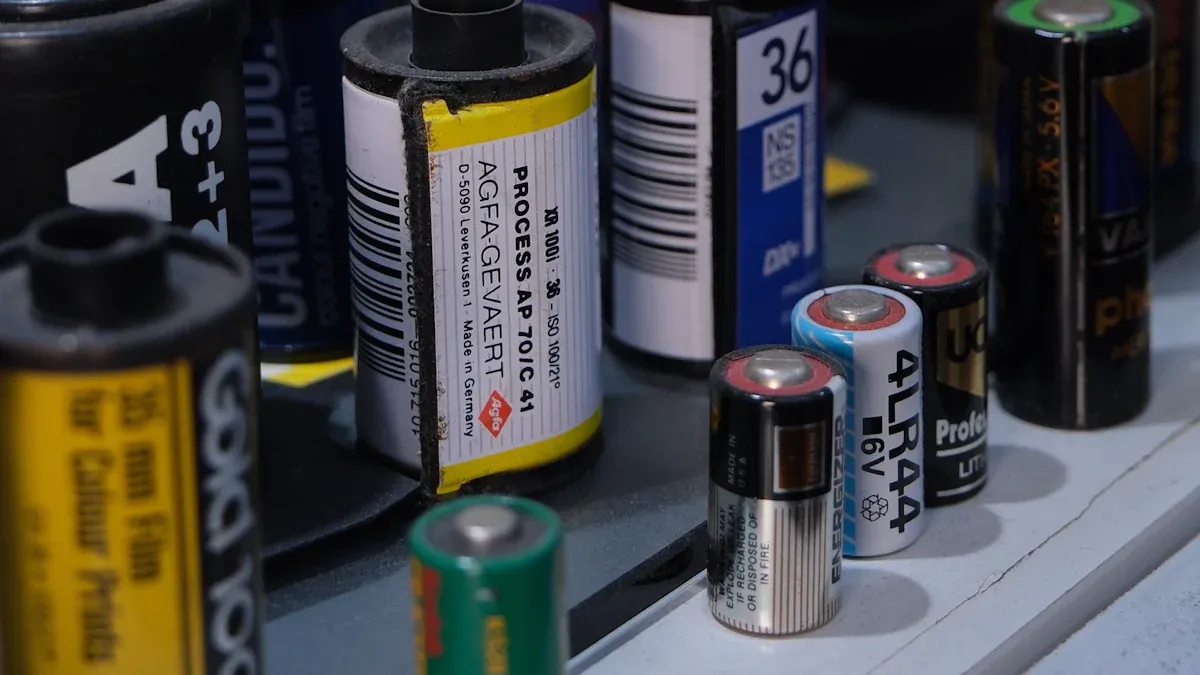
Types of Batteries Used in Digital Shelf Labels
Coin Cell Batteries
You will find coin cell batteries as the most common power source in digital shelf labels. These batteries, such as CR2032, CR2450, and CR2477, use lithium manganese dioxide chemistry. This composition provides a stable 3V output and capacities from 220mAh to 1000mAh. Coin cell batteries offer a low self-discharge rate—about 1% per year—and a shelf life of up to ten years. Their chemical stability allows digital shelf labels to operate reliably across a wide temperature range, from -30°C to 60°C. You benefit from minimal maintenance and consistent performance, making coin cell batteries ideal for large-scale retail deployments.
Lithium-Ion Batteries
Some digital shelf labels, especially interactive models that require frequent updates, use rechargeable lithium-ion batteries. These batteries support features like Bluetooth and NFC, which demand more power. You can recharge lithium-ion batteries, reducing waste and long-term costs. However, you must monitor their charge cycles and ensure proper charging infrastructure in your retail environment.
Alkaline Batteries
Alkaline batteries appear less frequently in digital shelf labels. You might encounter them in legacy systems or specific applications where cost is a primary concern. Alkaline batteries offer lower energy density and shorter lifespan compared to lithium-based options. You may need to replace them more often, which increases maintenance efforts in your retail operation.
Tip:
When selecting batteries for digital shelf labels, prioritize lithium coin cell batteries for their longevity and reliability in diverse retail settings.
Typical Battery Life in Retail
Average Lifespan in Retail Settings
You can expect the average battery life of coin cell-powered digital shelf labels in retail to range from 3 to 6 years. Industry leaders like Hanshow and SOLUM have developed models that extend battery life up to 10 years under moderate update conditions. For example, a large supermarket deploying thousands of digital shelf labels typically sees an average battery lifespan of about 5 years. This long lifespan reduces the frequency of battery replacements and supports efficient retail operations.
Factors Affecting Battery Longevity
Several factors influence how long batteries last in your digital shelf labels:
- Display refresh rate: Frequent updates drain batteries faster. Daily updates consume more power than weekly ones.
- Wireless communication method: Technologies like Bluetooth Low Energy (BLE) and optimized RF signals use less power than Wi-Fi.
- Display size and brightness: Larger or backlit displays require more energy than standard e-paper.
- Power management: Smart scheduling and minimal refresh cycles extend battery life, enabling up to 10 years on a single battery.
- Environmental impact: Proper sealing and high IP ratings protect against dust and moisture, supporting longer battery life.
- Battery technology: Coin-cell batteries like CR2450 or CR2430 are compact and cost-effective.
- Update frequency: More frequent updates reduce battery life, with lifespans ranging from 3-6 years for frequent updates to up to 10 years for minimal updates.
- Display technology: E-paper displays consume power only during refreshes, greatly extending battery life compared to LCDs.
- Wireless communication: Low-power protocols such as BLE reduce energy consumption.
- Environmental conditions: Temperature, humidity, and protection ratings affect battery and device longevity.
- Display size and brightness: Larger or illuminated displays consume more power.
- Power management: Intelligent scheduling and low-energy transmission methods maximize battery life.
For instance, the HS290 digital price label uses two CR2430 batteries, BLE 5.0 communication, and a 2.9-inch e-paper display, achieving about 5 years of battery life with 2-3 updates per day.
Battery Performance in Different Conditions
Temperature and Environmental Impact
You need digital shelf labels that perform reliably in various retail environments. Manufacturers design these devices with materials that resist extreme temperatures and high humidity. For example, VusionGroup’s V300 Freezer Series operates at temperatures as low as -25°C, making it suitable for refrigerated and freezer environments. Waterproof versions maintain display clarity and functionality in high-humidity conditions. Specialized coatings and AI-assisted solvent formulations further protect digital shelf labels from environmental degradation, supporting longer battery life and consistent performance.
Usage Patterns and Update Frequency
Your update patterns directly affect battery consumption in digital shelf labels. E-paper displays use power mainly when updating information. Frequent price changes or display refreshes increase energy use, leading to faster battery depletion. In high-update retail environments, you may face increased maintenance costs and more electronic waste due to frequent battery replacements. Manufacturers address these challenges by developing energy-efficient components and longer-lasting batteries. Some digital shelf labels now offer battery life up to 15 years, helping you balance update frequency with battery longevity and sustainability.
Alternative Power Methods for Electronic Shelf Labels
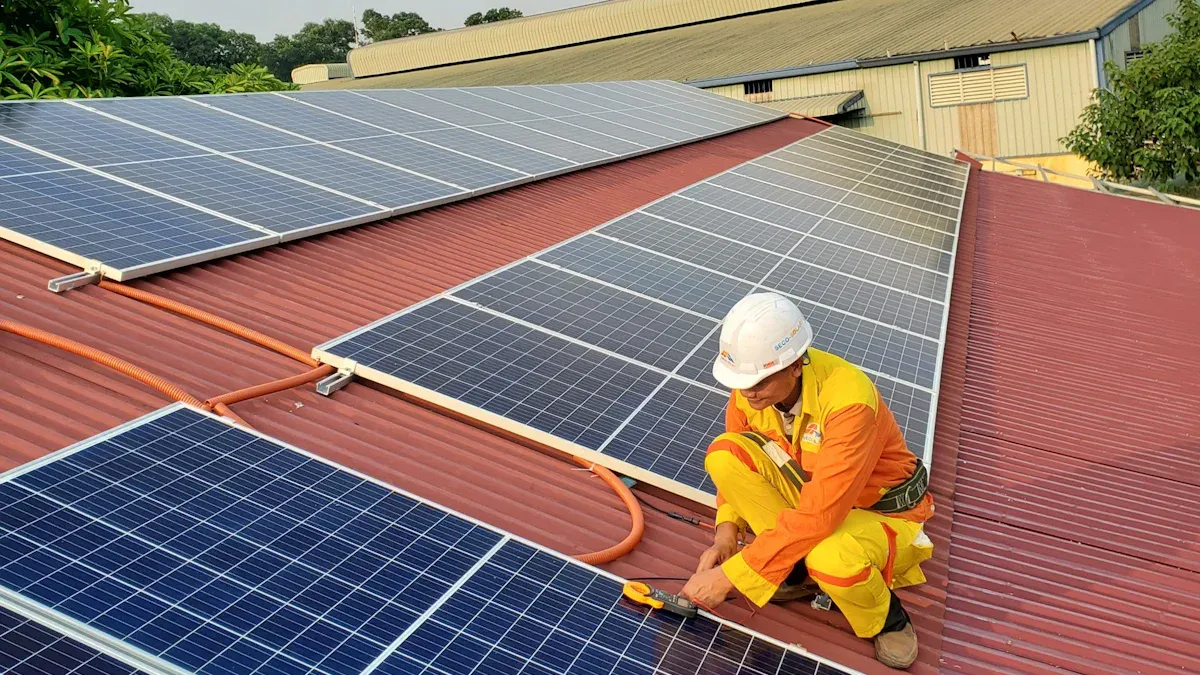
Energy Harvesting Technologies in Retail
Solar Power and Ambient Light
You can power digital shelf labels using solar panels and ambient light harvesting. Many modern digital shelf labels feature small photovoltaic cells that capture light from store environments. These cells convert light into electricity, which either supplements battery power or enables battery-free operation. You benefit from reduced maintenance because solar-powered digital shelf labels often last several years without battery replacement. Solar harvesting works best in well-lit retail spaces, especially near windows or under strong artificial lighting. This method supports sustainability goals and lowers long-term costs for your retail operation.
Radio Frequency Energy Harvesting
Digital shelf labels also use radio frequency (RF) energy harvesting. This technology captures energy from wireless signals in your retail environment, such as Wi-Fi or Bluetooth transmissions. RF harvesting provides enough power for low-energy digital shelf labels, especially those using Bluetooth Low Energy protocols. You gain flexibility because RF energy harvesting works in areas with limited light. However, the amount of energy collected depends on signal strength and distance from transmitters. Some advanced digital shelf labels combine RF harvesting with other sources, ensuring reliable performance and reducing battery dependence.
| Energy Harvesting Method | Power Density (Typical) | Efficiency Range |
|---|---|---|
| Solar Energy (outdoors, bright sunny day) | ~15 mW/cm³ | 10–25% |
| RF Energy Harvesting | 0.08 nW to 1 µW/cm² | 30–88% |
Solar power generally delivers higher power density, while RF harvesting offers variable efficiency. Both methods supply enough energy for digital shelf labels, but solar is more effective in bright environments.
Wired Power Solutions for Digital Shelf Labels
Direct Power Connections
You may choose direct wired connections for digital shelf labels in high-traffic or critical retail areas. Wired power ensures consistent energy delivery, eliminating battery maintenance. You connect digital shelf labels to the store’s electrical system, which supports continuous operation and frequent updates. This solution suits large displays or interactive digital shelf labels that require more power than batteries or energy harvesting can provide.
Power over Ethernet (PoE)
Power over Ethernet (PoE) offers another wired solution for digital shelf labels. You use a single Ethernet cable to deliver both power and data, simplifying installation and reducing costs. PoE supports easy expansion and modification of your digital shelf label system. You manage power centrally, allowing remote monitoring and troubleshooting. PoE enables automatic updates, ensuring pricing accuracy and supporting dynamic pricing strategies. These features improve scalability and maintenance efficiency in your retail environment.
- PoE delivers power and data over one cable, reducing complexity.
- You expand or modify digital shelf labels easily without major electrical work.
- Centralized management allows remote monitoring and reduces downtime.
- PoE supports automatic updates for digital shelf labels, maintaining accuracy.
Pros and Cons of Alternative Power in Retail
Advantages in Store Environments
You gain several benefits by using alternative power methods for digital shelf labels:
- Lower maintenance costs due to fewer battery replacements.
- Enhanced sustainability with reduced electronic waste.
- Reliable operation in diverse retail conditions.
- Flexibility to deploy digital shelf labels in areas with limited access to power outlets.
Alternative power methods, such as solar and RF harvesting, extend battery life and sometimes eliminate batteries altogether. You support a more sustainable and cost-effective retail environment.
Limitations and Challenges
You face some challenges when implementing alternative power for digital shelf labels:
- Solar harvesting depends on light availability, limiting placement options.
- RF energy harvesting varies with signal strength and may require additional energy storage.
- Wired solutions increase installation complexity and may restrict mobility.
- Initial investment for advanced digital shelf labels can be higher, but maintenance costs decrease over time.
| Cost Factor | E-Ink ESLs | LCD ESLs |
|---|---|---|
| Initial Investment | Higher upfront cost due to advanced bistable technology | Lower upfront cost per unit |
| Battery Life | Up to 5 years per battery | 1-2 years, requiring frequent replacements |
| Maintenance Needs | Minimal due to long battery life and durability | Frequent due to battery swaps and fragility |
| Durability | Shock-resistant, no glass, works in extreme temperatures | Prone to cracks, backlight failures, temperature sensitive |
| Total Cost Over 5 Years | Lower overall due to reduced maintenance and replacements | Higher due to energy use and frequent upkeep |
You should weigh these factors when choosing the best power solution for your digital shelf labels in retail.
Power Efficiency Strategies in Electronic Shelf Labels
Low-Power Display Technologies for Retail
E-Paper Displays
You achieve significant energy savings in digital shelf labels by choosing e-paper displays. E-paper technology, such as electrochromic and electrophoretic displays, consumes power only during updates. When your digital price displays remain static, the display uses almost no energy. Electrochromic e-paper displays require approximately 1.67 µW/cm² during updates and just 1–2 µW/cm² to maintain a static image. This ultra-low power profile allows digital shelf labels to operate for over ten years on a single coin cell battery, reducing maintenance and supporting sustainability in retail.
| Display Type | Power Consumption Characteristics |
|---|---|
| E-paper ESL | Consumes power only during content updates; very low ongoing power use; long battery life (up to 15 years) |
| LCD ESL | Requires constant power to maintain brightness and display; moderate to high energy consumption |
E-paper displays also align with your sustainability goals and help you minimize energy costs over time. Devices like the Kindle Paperwhite demonstrate the efficiency of e-paper, lasting weeks on a single charge compared to LCD devices that require daily charging.
LCD and Other Display Types
You may encounter LCD displays in digital shelf labels, especially where frequent updates or animations are required. LCD technology demands continuous power to maintain brightness, which increases energy consumption. Reflective LCDs offer lower power usage than traditional LCDs but still consume more energy than e-paper. LCD labels suit environments with high-frequency pricing changes, but you should expect shorter battery life and higher maintenance needs.
| Display Technology | Power Efficiency | Switching Frequency Suitability | Cost and Production | Flexibility and Viewing Angle | Operating Temperature Range |
|---|---|---|---|---|---|
| Electrochromic Displays | Ultra-low power (~1.67 µW/cm²), semi-bistable | Best for medium-frequency switching (4-600 updates/day) | Cost-effective, roll-to-roll printing | Flexible, wide viewing angle | -20 °C to 60 °C |
| Electrophoretic Displays | Low power, bistable | Suitable for low to medium frequency switching | More expensive | Not flexible, wide viewing angle | 0 °C to 50 °C |
| Reflective LCDs | Low power, higher than electrochromic | Best for high-frequency switching (>600 updates/day) | Very low cost, mature technology | Limited viewing angle | -40 °C to +85 °C |
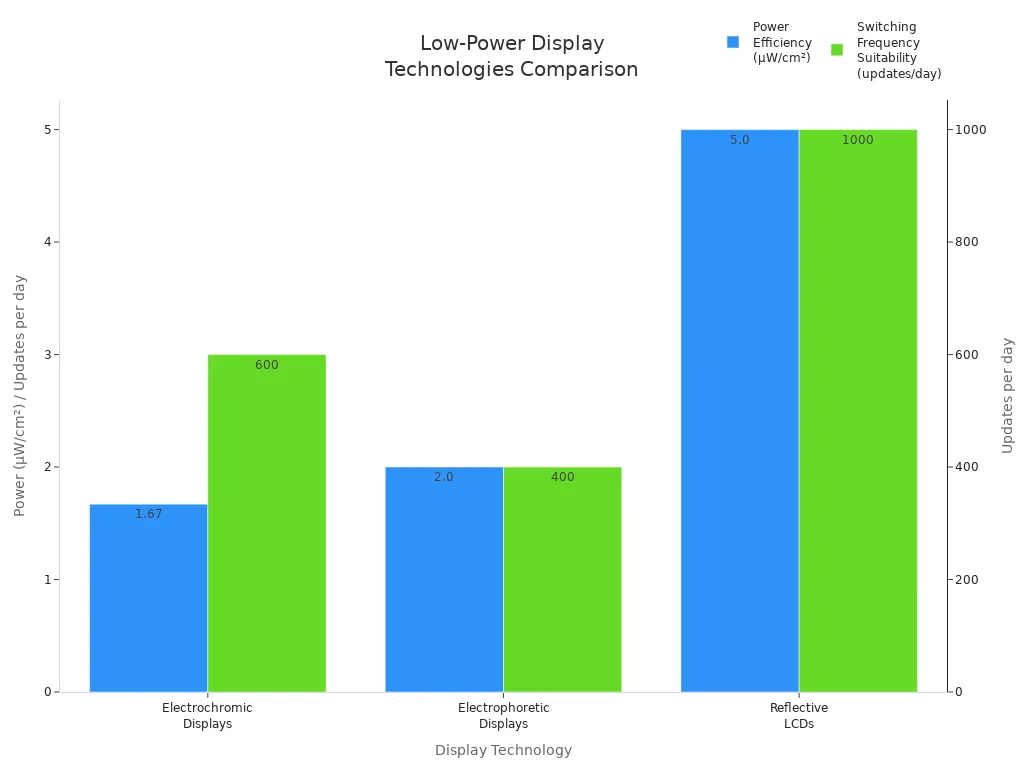
Communication Protocols in Digital Shelf Labels
Low-Energy Wireless Standards
You extend battery life in digital shelf labels by using low-energy wireless protocols. Bluetooth Low Energy (LE), especially Bluetooth Core 5.4 with the Electronic Shelf Label Profile, supports scalable, secure, and ultra-low power communication. Features like Periodic Advertising with Responses (PAwR) enable efficient, synchronized updates for thousands of digital shelf labels in retail. Proprietary protocols from Silicon Labs also operate in ultra-low-power modes, using RFSENSE wake-on radio to keep devices in sleep mode until needed. These standards help you minimize energy consumption and reduce the total cost of ownership.
- Bluetooth LE networks support large-scale, bidirectional communication with minimal energy drain.
- Optimized SoCs, such as EFR32BG22, allow battery lifetimes of 5–10 years by minimizing current draw during transmission and sleep.
Update Frequency Optimization
You can further reduce energy use by optimizing update frequency. Each update operation consumes energy, so limiting unnecessary pricing changes or scheduling updates during off-peak hours helps conserve battery life. For example, a single update may take 5.2 seconds and consume 75 mJ. By minimizing the number of updates, you extend the operational life of your digital shelf labels and maintain pricing accuracy without frequent maintenance.
| Design Aspect | Description / Measurement |
|---|---|
| Energy buffer capacity (R1) | Minimized to a single operation per full charge (one EPD update) |
| Power source (R2) | External RF energy source only |
| Charge time (R4) | Optimized to minimize, maximizing responsiveness |
| Peripheral hardware energy (R6) | Minimized energy consumption |
| Update operation energy | One update takes 5.2 seconds and consumes 75 mJ |
Smart Power Management in Electronic Shelf Labels
Sleep Modes and Wake-Up Triggers
You maximize energy efficiency in digital shelf labels by leveraging smart power management features. Devices spend most of their time in deep sleep mode, drawing as little as 0.10 mA. Wake-up triggers, such as radio signals or scheduled events, activate the device only when necessary. This approach drastically reduces energy consumption compared to active states like transmission or network registration.
| Device State | Description | Duration (ms) | Avg. Current (mA) | Energy (mJ) |
|---|---|---|---|---|
| Initialization | Device startup and setup | 5390 | 8.46 | 167.52 |
| Module Activation | Network registration process | 11030 | 57.63 | 2326.22 |
| Connection | Opening communication socket | 6930 | 28.07 | 717.94 |
| eDRX (Paging) | Listening for downlink messages | 31000 | 9.58 | 1089.65 |
| Transmission (Tx) | Sending data payload | 373 | 46.12 | 63.48 |
| Deep Sleep | Low power inactive state | Variable | 0.10 | Variable |
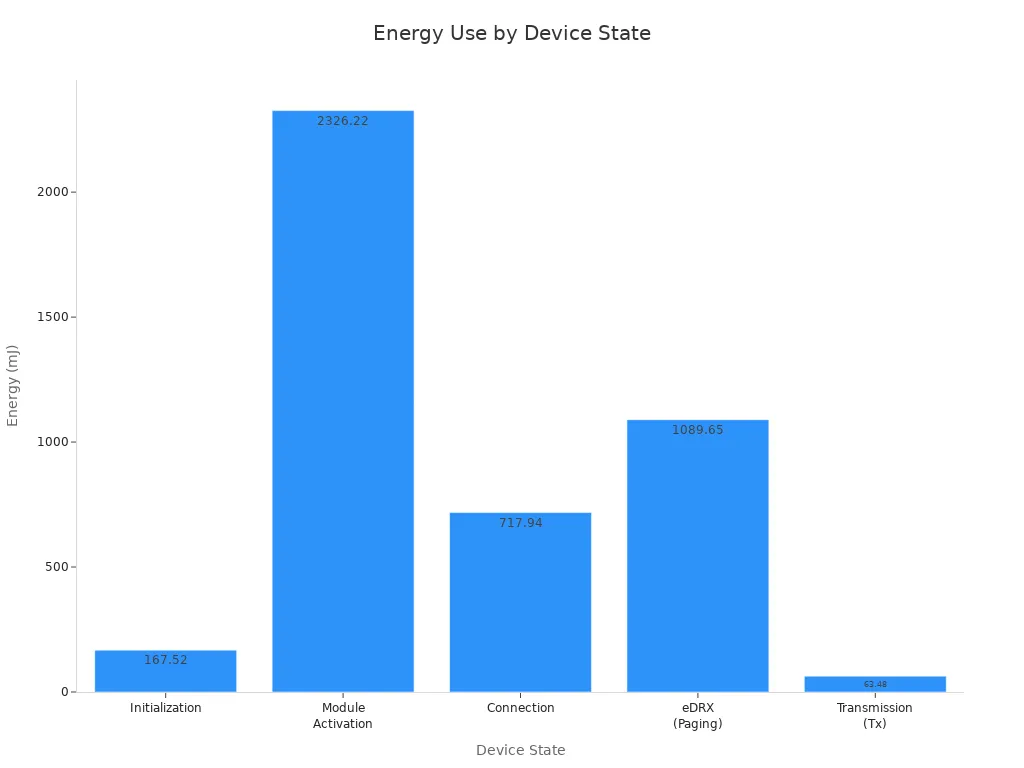
Adaptive Power Usage
You benefit from adaptive power management algorithms that dynamically balance active and sleep periods. By adjusting sampling intervals and managing awake time for sensor readings, data transmission, and reception, your digital shelf labels minimize energy use while maintaining pricing accuracy. IoT capabilities allow you to monitor battery health, predict charging needs, and automate energy optimization. These strategies support eco-friendly retail operations and extend the lifespan of your digital shelf labels, enhancing price accuracy and reducing maintenance.
Tip:
Integrate low-power display technologies, optimize wireless protocols, and use smart power management to maximize battery life and reliability in your electronic shelflabels.
Maintenance and Replacement of Power Sources in Retail
Battery Replacement Procedures for Electronic Shelf Labels
Replacement Frequency
You should expect batteries in digital shelf labels to last several years, even in busy retail environments. Most digital shelf labels use batteries like CR2450 or CR2430, which typically provide up to five years of service with moderate update rates. However, if your store experiences frequent pricing changes or high customer traffic, you may need to replace batteries more often. Environmental factors, display complexity, and the specific digital technology in use also influence battery life. In most cases, you will plan for battery replacement cycles measured in years, not months.
Tools and Training Needed
You can streamline battery replacement by following a clear process. Use management software to monitor battery health and set reminders for regular checks. When it is time to replace a battery, power down the digital shelf label, use only approved batteries, and insert them with the correct polarity. Securely close the compartment and dispose of old batteries responsibly. After replacement, test the digital shelf label to confirm proper operation. You should train staff on these procedures and provide basic tools, such as small screwdrivers and battery testers. Scheduling replacements during low-traffic hours helps you avoid disrupting retail operations.
Proactive battery management supports smooth store functioning and reduces operational costs.
Monitoring Power Levels in Digital Shelf Labels
Automated Alerts and Notifications
You can rely on proactive power monitoring to keep your digital shelf labels running smoothly. Management systems continuously track battery levels and power status for each digital shelf label. Automated alerts notify your staff before batteries run low, allowing timely replacements. These notifications help you avoid unexpected pricing errors and maintain accurate digital pricing displays.
Preventing Downtime
You prevent downtime by acting on early warnings from your monitoring system. Automated fault alarms reduce the need for manual checks and enable quick responses to potential issues. Escalation procedures ensure that unresolved problems receive prompt attention. This approach protects your digital shelf labels from losing power, which keeps your pricing accurate and your retail operations efficient.
Impact on Store Operations in Retail
Labor and Cost Considerations
You must consider labor and cost when maintaining digital shelf labels. Proactive battery management and automated monitoring reduce the time your staff spends on manual checks. By planning replacements and using energy-efficient batteries, you lower operational costs. Choosing digital shelf labels with long battery life and easy replacement features further minimizes labor requirements.
Minimizing Disruption
You can minimize disruption by scheduling maintenance during off-peak hours and selecting digital shelf labels designed for straightforward installation and upkeep. Hardwired digital shelf labels provide continuous operation, reducing interruptions. Monitoring device health helps you anticipate maintenance needs and avoid unexpected disruptions. These strategies ensure your pricing remains accurate and your retail environment stays efficient.
Reliability and Longevity of Electronic Shelf Labels in Retail Environments
Ensuring Consistent Performance of Digital Shelf Labels
Redundancy and Backup Systems
You need digital shelf labels that deliver consistent performance, even in demanding retail environments. Manufacturers design these systems with redundancy in mind. Many solutions use robust wireless protocols like 2.4GHz, Bluetooth, or Wi-Fi to maintain stable communication. If one network channel fails, the system can switch to another, ensuring your pricing updates reach every label. Centralized management platforms allow you to monitor and control hundreds of labels remotely. This setup lets you identify issues quickly and deploy fixes before they disrupt store operations. Some digital shelf labels also feature IP67-rated enclosures, making them shock-proof, dust-proof, and water-resistant. These features protect your investment and keep your pricing accurate, even during power interruptions or environmental challenges.
Quality Control Measures
You can trust digital shelf labels to perform reliably because manufacturers implement strict quality control measures. Before full deployment, you should conduct pilot testing and sample testing to catch potential problems early. Durable construction helps labels withstand temperature swings and frequent handling. Many models offer a 10-year battery life, reducing the need for frequent maintenance. Integration with your existing retail management systems ensures seamless operation and easy scalability. Security features, such as encrypted communication, protect sensitive pricing data from unauthorized access. Staff training and technical support further enhance reliability, empowering your team to handle any issues efficiently.
Tip:
Choose digital shelf labels with centralized management and robust wireless connectivity to maximize uptime and minimize disruptions.
Environmental and Sustainability Factors in Retail
Battery Recycling and Disposal
You play a key role in promoting sustainability by managing battery recycling and disposal responsibly. Most digital shelf labels use lithium coin cell batteries, which require proper handling at the end of their life cycle. Set up collection points in your store for used batteries and partner with certified recycling services. This approach prevents harmful chemicals from entering the environment and supports your corporate social responsibility goals. Many manufacturers provide guidelines for safe battery removal and disposal, making the process straightforward for your staff.
Eco-Friendly Power Options
You can further enhance sustainability by selecting eco-friendly power options for your digital shelf labels. Solar-powered models use ambient light to reduce battery dependence, while energy harvesting from radio frequency signals offers another green alternative. E-paper display technology consumes minimal energy, extending battery life and lowering your store’s carbon footprint. Some digital shelf labels feature programmable buttons and NFC capabilities, allowing you to streamline operations without increasing energy use. By choosing these solutions, you support a more sustainable retail environment and demonstrate your commitment to environmental stewardship.
Future Trends in Powering Electronic Shelf Labels
Advances in Battery Technology for Digital Shelf Labels
Longer-Lasting Batteries
You will see major improvements in battery technology for digital shelf labels over the next few years. Solid-state batteries now replace liquid electrolytes with solid materials, which increases energy density and safety. This change means your digital shelf labels can run longer between replacements and face less risk of overheating. Graphene-based batteries also enter the market, offering faster recharging and higher efficiency. You can recharge these batteries quickly during off-peak hours, which keeps your pricing displays active with minimal downtime.
Advanced lithium-ion batteries use optimized cathode materials and silicon anodes. These features help manage heat, extend battery life, and support faster charging cycles. When you combine these batteries with low-power display technologies like e-paper, your digital shelf labels can operate for years without interruption. Manufacturers also focus on sustainable materials and eco-friendly production, which aligns with your store’s environmental goals.
Note:
Longer-lasting batteries reduce replacement needs and support large-scale deployments, making your pricing management more efficient.
Faster Charging Solutions
You benefit from new charging solutions that minimize downtime for your digital shelf labels. Graphene-based and advanced lithium-ion batteries now support rapid charging, so you can refresh your devices quickly during scheduled maintenance. Some systems, like the SOLUM gateway, enable near-instant pricing updates without increasing energy consumption. This synergy between battery technology and smart charging ensures your digital shelf labels remain responsive and reliable.
Emerging Power Solutions in Retail
Wireless Charging
Wireless charging is becoming a practical option for digital shelf labels. You can deploy charging pads or transmitters along store shelves, allowing your devices to recharge automatically without manual intervention. This approach eliminates the need for frequent battery swaps and reduces labor costs. Wireless charging also supports flexible store layouts, as you can move and update your pricing displays without worrying about power cables.
Integration with Smart Store Systems
You gain even more efficiency by integrating digital shelf labels with smart store systems. Ultra-low-power wireless System on Chips (SoCs), such as the EFR32FG22 and EFR32BG22 series, enable your devices to achieve battery lifetimes up to 10 years using standard coin cell batteries. These SoCs maintain a current budget below 10µA, covering e-ink display updates and wireless communication. Features like deep sleep modes and RFSENSE wake-on radio technology keep your devices in ultra-low power states until a dedicated signal wakes them. Enhanced variants even support battery-less designs through energy harvesting.
You can also leverage development tools and SDKs to optimize power consumption and simplify radio design. This integration ensures your pricing updates remain accurate and timely, while your digital shelf labels operate reliably and securely.
| Power Solution | Key Benefit | Impact on Retail Operations |
|---|---|---|
| Solid-State Batteries | Higher energy density | Longer device uptime |
| Graphene Batteries | Fast charging, high efficiency | Reduced downtime |
| Wireless Charging | No manual battery swaps | Flexible shelf layouts |
| Ultra-Low-Power SoCs | Extended battery life | Reliable, secure pricing updates |
You have several power options for electronic shelf labels, including batteries, energy harvesting, and wired connections. Efficient and reliable power keeps your pricing accurate and your store running smoothly. New battery technologies and smart energy management help you reduce maintenance and support sustainability.
When you evaluate digital shelf label systems, always consider the power solution. The right choice improves your store’s efficiency and enhances the customer experience.
FAQ
How often do you need to replace batteries in electronic shelf labels?
You typically replace batteries every 3 to 6 years. The exact interval depends on update frequency, display technology, and environmental conditions. Monitoring systems help you plan replacements efficiently.
Can you use solar power for electronic shelf labels in all store areas?
You can use solar-powered labels in well-lit areas. Low-light or shaded locations may not provide enough energy. Evaluate your store’s lighting before choosing solar options.
What happens if a digital shelf label loses power?
If a label loses power, it may stop updating prices or go blank. Most e-paper displays retain the last image until you restore power. Automated alerts help you prevent downtime.
Are electronic shelf labels safe for refrigerated or freezer environments?
You can install specialized digital shelf labels designed for cold storage. These models withstand low temperatures and high humidity. Always check the manufacturer’s specifications for environmental ratings.
How do you monitor the power status of your digital shelf labels?
You use centralized management software to track battery levels and receive automated alerts. This system helps you schedule maintenance and avoid unexpected outages.
What are the main benefits of using energy harvesting in retail?
You reduce battery replacements, lower maintenance costs, and support sustainability goals. Energy harvesting methods, such as solar or RF, provide reliable power in suitable environments.


